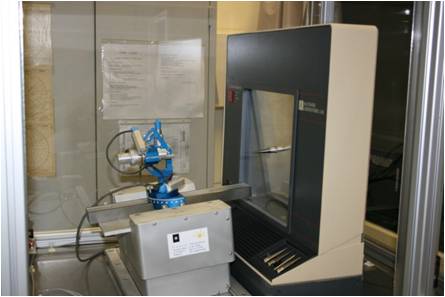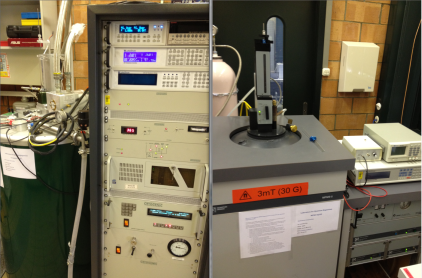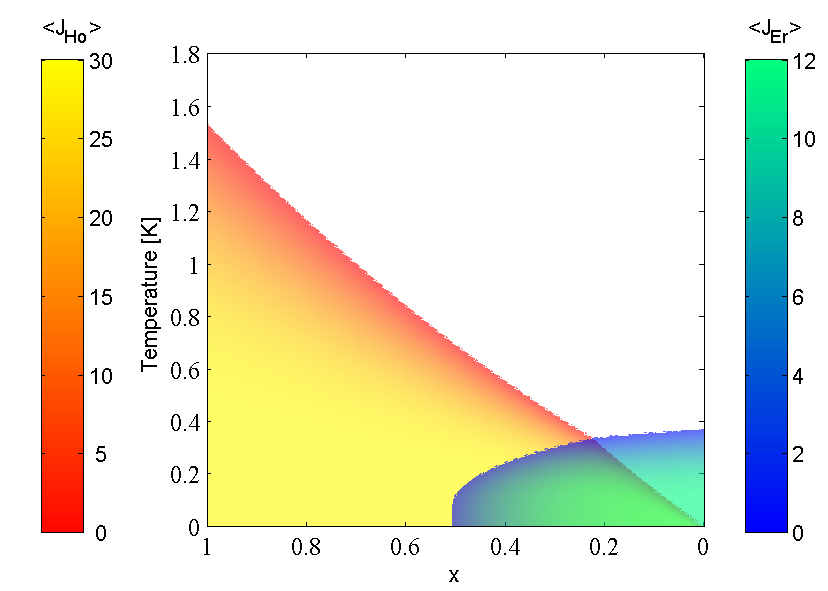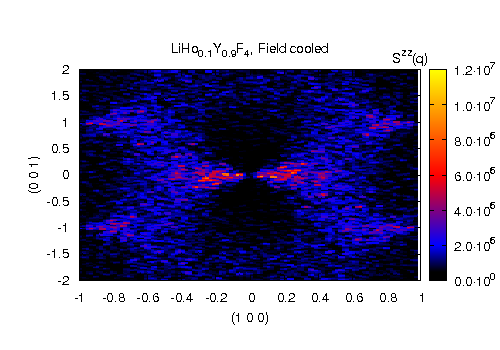LQM-Facilities
The Laboratory for Quantum Magnetism (LQM) and, more widely the Institute for Condensed Matter Physics (IPMC), has acquired a suite of facilities and experimental capabilities valuable for low-temperature research in the physics of correlated electron materials. We are always open for collaborations and services.
Sample preparation

Real-time X-ray Laue camera
with multi-wire detector for alignment of single crystal samples. The Laue camera is located in the PH0 493 X-ray laboratory. Before usage, please contact the responsible person: Luc Testa.
Manufacturer: www.multiwire.com and www.lauecamera.com.
Sample cutting and polishing laboratory (IPMC)
IPMC hosts a selection of wire and diamond-disc saws for cutting samples, and excellent polishing capabilties down to Angstrom roughness. Several goniometers exist allowing transfer of aligned crystals from the real-time Laue camera to the cutting machines. The cutting machines are in the PH K1 521 metallography lab. Before usage, please contact Prof. Henrik Ronnow.
Synthesis
Solvent evaporation crystalization facility
Hydrothermal synthesis. Teflon lined bombs, withh external pressure control, glass-bombs
2 Julabo thermal baths, computer controlable
2 Memert ovens, one computer controlable
Examples of materials and crystals synthesized
Magnetometry

Within the LQM we operate two versatile magnetometers. The first instrument is a very flexible Cryogenic SQUID allowing environments from 0.3 K (He3 insert) to 700 K (furnace). It is possible to measure DC magnetization as well as longitudinal and transversal AC susceptibility with an applied permanent (DC) field in the range of -7 T to 7 T.
The second one is a standard Quantum Design MPMS system, allowing measurements of magnetization M(H,T) (temperature scans, hysteresis etc.) in temperatures from 2 K- 400 K and in a range of magnetic fields from -5 T to 5 T.
The usage of LQM’s magnetometers by academic users typically implies a collaboration with LQM. However, skilled users may use the MPMS magnetometer for brief periods of time (1-2 days) wihout coauthorship obligations if they do not require anything except a basic introduction to the lab and instrument. In this case, however, we would like to have “measured at the LQM, EPFL” mentioned in the acknowledgments of the resulting publication to satisfy the funding agencies. The publication should also be forwarded to the instrument responsible. In all other cases we do require coauthorship of an LQM member. It is a fair deal since it takes away man-hours and equipment-hours from LQM. Finally, for interesting topics, we are happy to perform measurements and/or analysis ourselves.
Both magnetometers are situated in PH K0 490. For further information regarding LQM’s magnetometers, please contact Dr. Iviça Zivkovic (ivica.zivkovic@epfl.ch)
Susceptibility
AC-susceptibility, two sentences on technique
Vertical coils, horizontal coils, miniature coils, insitu-neutron-coils
Down to 30mK, up to 9T, 0.1Hz-10kHz
Cryostats and magnets
9T system with 30mK dilution
14T system with 300mK 3He fridge
4K VTI dip stick
Computing
Share a linux cluster…
Tesla personal GPU supercomputer
Pink instrument control program
iMF
Spec1D
McStas. Prof. Henrik M. Ronnow took part in the conception of McStas – a worldwide accepted standard for ray-tracing simulation of neutron spectrometers.
High-pressure measurements
The LQM has the access and expertise for the study of pressure-dependent sample properties using both in-house and facility-based pressure cells. In-house options constitute a 30 kbar cell with wire-feedthrough that allows the study of bulk properties at liquid helium temperatures (4.2 K), and a 10 kbar cell can be used in combination with the Cryogenic SQUID for routine magnetic property measurements for temperatures down to 1.4 K.
LQM is also involved in the regular use and maintenance of pressure cells optimized for neutron scattering experiments at the Paul Scherrer Institute (PSI). Clamp cells optimized for both inelastic and elastic neutron scattering respectively provide sample pressures up 17 kbar and 15 kbar at liquid helium temperatures, and on both single crystal and powder samples. Also available is a Paris-Edinburgh Press with dedicated cryocooler. This equipment allows the study of powder samples under applies pressures of up to 100 kbar, and at temperatures down to 2 K.
Spec1d
A versatile set of tools to analyse 1d data sets in MATLAB
A collection of routines designed to facilitate the analysis of one dimensional (i.e. x, y, error) data sets from the command line in MATLAB. Data can be loaded into a structure, known as a spec1d object, and then processed with simple one-line commands. Liberal use is made of the operator overload feature of MATLAB5 so that operators such ‘+’, ‘*’ are redefined to work on 1d spectra, including the correct handling of error propogation. Using spec1d it is possible to perform complex data analysis, including non-linear least-squares fitting, in a very efficient manner. As it makes use of the load and function libraries from MFIT/MVIEW, it is completely general, and can be used to analyse data from more or less any source.
Requires MATLAB 5.1 or higher.

Virtual Crystal Mean Field
A mean field calculation tool to calculate doped materials magnetic properties in MATLAB.
The Virtual Crystal Mean Field algorithm is a powerful yet simple algorithm to calculate the magnetic properties of doped materials. The doping is taken in account by mixing the mean field from the different ion kinds with the appropriate ratio.

Order parameter vs temperature and doping for LiHo/ErF4
Inhomogenuous Mean Field
A mean field program to compute magnetic properties of doped materials accounting for disorder.
One of the main limitations from the above Virtual Crystal Mean Field program is that disorder effects are neglected. Disorder is a key ingredient to many exotic magnetic phases. This program calculate the magnetic state over a large disorder realization.
This program is parallelized in order to use the Message Passing Interface (MPI) and optionnaly the computing power now available on the graphical cards using NVIDIA CUDA programming language.

Spin-Spin correlation function Fourier transform of LiHo/YF4 with 10% Holmium.
Python Instrument Control (Pinklib)
A versatile instrument control software that uses the National Instruments VISA specification.